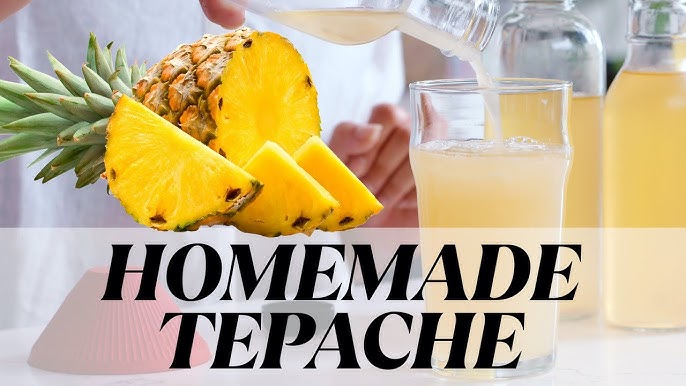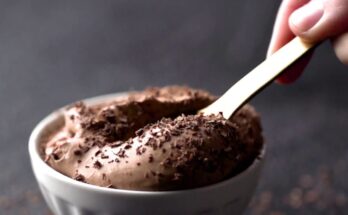Tepache Recipe: Tepache is a traditional Mexican fermented drink made primarily from the peel and rind of pineapples, sweetened with brown sugar (traditionally piloncillo), and spiced with cinnamon or cloves. It’s slightly fizzy, subtly tangy, and refreshingly sweet, often enjoyed chilled on hot days. Unlike kombucha or beer, tepache is incredibly easy to make, requires minimal ingredients, and ferments quickly, making it perfect for beginners in home fermentation.
One of the coolest things about tepache is how it takes something you’d normally throw away—pineapple skins—and turns it into a delicious, probiotic-rich beverage. It’s a zero-waste recipe that aligns perfectly with sustainable living practices. Plus, since it ferments naturally with wild yeasts from the fruit and air, there’s no need to buy a starter culture.
Tepache is non-alcoholic to low-alcohol depending on how long it ferments, usually under 1% ABV after 2-3 days of fermentation. However, if left longer or fermented with additional sugar, the alcohol content can increase slightly. It’s a versatile drink you can tailor to your taste preferences and health goals.
Origins and Cultural Significance
Tepache has deep roots in Mexican culinary traditions, particularly in indigenous and rural communities. Historically, it was made using corn (a version still known as “tepache de maíz”), but with the introduction of pineapple to Mexico in the colonial period, the fruit-based version became more popular.
It’s commonly sold by street vendors in large glass jugs, often poured over ice in plastic cups. Tepache represents not just refreshment but also a connection to heritage, simplicity, and the spirit of sharing. In recent years, its popularity has crossed borders, with foodies and fermentation enthusiasts around the globe embracing its unique flavor and ease of preparation.
Why Make Tepache at Home?
Health Benefits
Making tepache at home isn’t just about having a tasty drink—it also packs some surprising health perks. Because it’s fermented, tepache contains beneficial bacteria, also known as probiotics. These support gut health, enhance digestion, and even contribute to a stronger immune system. If you’ve ever paid big bucks for kombucha or probiotic supplements, know that tepache gives you similar benefits at a fraction of the cost.
Plus, because you control the ingredients, you can keep it as natural and healthy as you like. Want to skip refined sugar? Use organic brown sugar or coconut sugar. Want more spice? Add fresh ginger or turmeric. You’re the boss of your brew.
And don’t forget the natural vitamins from pineapple—especially vitamin C, which helps with skin health, immunity, and inflammation. All of this, in a delicious, fizzy drink that feels like a tropical vacation in a glass.
Cost-Effectiveness and Sustainability
Store-bought drinks are pricey. A bottle of kombucha might run you $4–$6, and that adds up fast. But with tepache, you’re working with pineapple skins—something you’d usually toss out. That’s a double win: saving money and reducing food waste.
Let’s break it down: you buy a pineapple for $3. Eat the fruit, save the peels. Add sugar and water, let it sit for a few days, and boom—you’ve made up to two liters of a fermented beverage for under $5 total. That’s less than $1 per glass.
And because tepache doesn’t need fancy equipment or a sterile lab-like setting, it’s one of the most approachable drinks for home fermentation. No waste, low cost, high reward.
Ingredients Needed for Tepache
Core Ingredients
To get started with tepache, you’ll need just a few simple ingredients. Most of these are already in your kitchen or can be found easily at any grocery store:
- 1 ripe pineapple (use the peel and core, not the flesh)
- 1 to 1½ cups of brown sugar (or piloncillo, if you can find it)
- 4–6 cups of filtered water
That’s it. These three ingredients form the foundation of any good tepache. The pineapple peel is where the wild yeast and bacteria live, which kickstart the fermentation process. Brown sugar feeds those microorganisms, and water helps it all meld together into a beautifully bubbly drink.
It’s important to choose a ripe, organic pineapple if possible. Since you’ll be fermenting the peels, you want to avoid pesticides and wax coatings found on non-organic fruit. If organic isn’t an option, give your pineapple a good scrub with a vinegar rinse before using.
Optional Flavor Enhancers
While the basic recipe is fantastic on its own, tepache is super customizable. You can jazz it up with spices and fruits to match your mood or the season. Here are some popular additions:
- Cinnamon sticks (adds warmth and depth)
- Cloves or allspice (for holiday vibes)
- Fresh ginger (for a spicy kick and more digestive support)
- Star anise (a licorice-like twist)
- Orange or lime peel (brightens up the flavor)
- Fresh fruit chunks like mango, apple, or berries (adds natural sweetness and variety)
Mix and match to find your perfect blend. Just keep in mind that strong spices or too much added sugar can speed up fermentation—so taste often and adjust as needed.
Tools and Equipment Required
Basic Kitchen Tools
You don’t need a high-tech setup to make tepache. In fact, one of the best things about this drink is how accessible it is. Here’s what you’ll need to get started with the basic kitchen tools:
- A large glass jar or pitcher (1 to 2 gallons)
- A wooden spoon or silicone spatula
- A clean kitchen towel or cheesecloth
- Rubber band or kitchen twine (to secure the cloth)
- Strainer or fine mesh sieve
Glass is the preferred container because it doesn’t react with the acids and microbes like metal might. You want something big enough to hold the pineapple peels, water, and sugar with room for the fermentation bubbles to rise.
Using a cloth and rubber band to cover the jar allows air to circulate while keeping bugs and debris out. Avoid sealing the container with a tight lid during fermentation—you’ll trap gases and risk a messy explosion or pressure buildup.
Recommended Fermentation Gear
If you’re planning to make tepache regularly, a few upgrades can make your fermentation journey easier and cleaner:
- Fermentation weight – Keeps fruit submerged to avoid mold.
- Fermentation airlock lid – Reduces the risk of contamination while allowing gases to escape.
- Flip-top glass bottles – Great for storing the final product and getting extra fizz during second fermentation.
- pH strips or a hydrometer – Helpful for monitoring the fermentation process scientifically, especially if you want consistency.
These tools aren’t essential for beginners, but they can elevate your homebrew game and give you more control over flavor and carbonation.
Step-by-Step Guide to Making Tepache
Step 1: Clean and Prep the Pineapple
Start with a ripe pineapple—bright yellow, slightly soft to the touch, and fragrant. This ensures there’s plenty of natural sugar and yeast for fermentation. Here’s what to do:
- Rinse the pineapple thoroughly, scrubbing off any dirt.
- For non-organic pineapples, soak in a water-vinegar solution (1:3 ratio) for 10–15 minutes to remove pesticide residue.
- Pat dry and peel the pineapple, saving the skin and core. You can eat the fruit or use it in smoothies while saving the rest for tepache.
Make sure you don’t use any rotten or moldy parts of the pineapple. Fresh, clean peels are key to safe fermentation.
Step 2: Combine Ingredients
In a large glass jar:
- Add the pineapple skins and core.
- Pour in 1 to 1½ cups of brown sugar (adjust to taste).
- Add any optional spices or flavorings—1–2 cinnamon sticks, a few cloves, or slices of ginger work well.
- Pour in 4–6 cups of filtered water, enough to submerge the ingredients but leave room at the top.
- Stir with a wooden spoon until the sugar dissolves.
Cover the jar with cheesecloth or a clean towel and secure it with a rubber band.
Step 3: Let It Ferment
Place the jar in a warm, shaded spot like your kitchen counter (out of direct sunlight). Let it sit for 2 to 4 days, depending on your climate and desired taste. Here’s what to expect:
- Day 1–2: The mixture will start bubbling. This means fermentation has begun.
- Day 3: Taste it. If it’s tangy, slightly sweet, and fizzy, it’s probably ready.
- Day 4: It may taste more sour or slightly alcoholic. If it smells off (like rotten eggs), discard it.
Stir the mixture once a day to prevent mold and ensure even fermentation. The surface may foam a bit—this is normal.
Step 4: Strain and Bottle
Once it reaches your desired flavor:
- Strain the liquid into a large bowl using a sieve or cheesecloth.
- Discard the solids or compost them.
- Pour the strained tepache into glass bottles with tight-sealing caps. Leave some space at the top.
You can now enjoy it as-is or move on to a second fermentation for more fizz.
Step 5: Chill and Enjoy
Refrigerate the bottled tepache for at least a few hours to chill. Serve over ice or straight from the bottle. It’s crisp, refreshing, and pairs beautifully with tacos, grilled meats, or spicy dishes.
If you opt for second fermentation, leave the sealed bottles at room temperature for 1–2 more days to boost carbonation, then refrigerate. Be cautious—check pressure daily to avoid bursting bottles.
Tips for Perfect Fermentation
Ideal Temperature and Timing
Tepache thrives in warm temperatures—between 70°F and 85°F (21°C to 29°C) is ideal. Cooler temperatures will slow fermentation, while hotter climates might cause it to ferment too quickly or even spoil. If your kitchen is cold, place the jar near a warm appliance like the fridge or wrap it in a towel.
The flavor evolves fast. A short 2-day ferment yields a mild, sweet drink, while a 4-day ferment becomes tangier and more complex. After 5 days, tepache can start turning into vinegar, so monitor it closely.
Troubleshooting Common Issues
- No bubbles after 2 days? Your room may be too cold or the sugar wasn’t fully dissolved. Stir well and move to a warmer spot.
- Too sour? Fermentation went too long. Add a splash of juice or more sugar when serving.
- Cloudy or white film? That’s usually harmless wild yeast or a biofilm. Skim it off. If you see green or black mold, toss the batch.
- Not fizzy enough? Try second fermentation in a sealed bottle at room temp for 1–2 days.
Always trust your senses. If it smells funky (like rotten eggs) or you see odd colors, play it safe and start over.
How to Store Tepache Properly
Short-Term Storage
Once your tepache is fermented to your liking and strained, it should be stored in the refrigerator. Cold temperatures slow down the fermentation process dramatically, which helps preserve the flavor you’ve worked to achieve. Store it in:
- Glass bottles with airtight seals – These help retain fizz and prevent contamination.
- Mason jars with tight lids – Good for smaller batches or if you plan to consume it within a few days.
Refrigerated tepache will keep well for about 5 to 7 days. The flavor may continue to develop slightly, and it might get a bit tangier. For best taste and fizz, drink it within this window.
You’ll also notice some sediment settling at the bottom. That’s totally normal—just give it a gentle swirl before pouring, or strain again if you prefer a clear drink.
Long-Term Preservation Options
If you want to keep your tepache longer, consider these options:
- Second Fermentation Refrigeration: Once you’ve done a second fermentation in sealed bottles (to boost carbonation), immediately move them to the fridge. This prevents over-fermentation and alcohol development.
- Freezing Tepache: Not commonly done, but you can freeze tepache in ice cube trays to use in cocktails or smoothies. Just note that freezing will kill most of the probiotics.
- Pasteurizing: Heat the tepache gently (not boiling) to kill active microbes and stabilize it for longer shelf life. This removes the probiotic benefit but keeps the flavor intact.
Keep an eye out for changes in smell, taste, or texture over time. If anything smells off or develops mold after refrigeration, it’s best to discard the batch.
Variations of Tepache
Tepache with Spices
Adding spices can take your homemade tepache from good to gourmet. A few common options include:
- Cinnamon sticks – Brings warmth and balances the sweetness.
- Cloves – Adds an earthy depth.
- Star anise – Offers a slightly sweet, licorice-like flavor.
- Ginger – Adds a spicy kick and boosts gut health.
Add these during the initial fermentation stage. One cinnamon stick and a few cloves are usually enough for a 1-gallon batch. Avoid over-spicing; you want these to complement, not overpower, the pineapple flavor.
Spiced tepache is especially popular in cooler seasons or as a unique offering at holiday gatherings. It makes for an excellent non-alcoholic alternative to mulled wine or cider.
Fruity Tepache Blends
For a twist on the classic, try adding other fruits. Some favorite fruity variations include:
- Mango – Tropical and creamy, blends well with pineapple.
- Apple – Adds crispness and a touch of tartness.
- Lime or Orange peel – Enhances the citrus notes.
- Berries – Gives tepache a rich color and a burst of natural sweetness.
Cut the fruits into chunks and add them with the pineapple peels. You’ll get subtle undertones of whichever fruit you choose. Just be careful—softer fruits like berries can ferment faster and may need to be removed after 1–2 days.
Experimenting with different combinations keeps tepache exciting and lets you tailor it to your tastes or the season.
Serving Suggestions
Pairing Tepache with Meals
Tepache’s sweet, tangy, and slightly fizzy profile makes it an ideal beverage to pair with a variety of foods. In Mexico, it’s often served alongside:
- Tacos (especially spicy or smoky ones)
- Grilled meats and seafood
- Street foods like elote or tamales
- Breakfast dishes like chilaquiles
It’s also a great palate cleanser between bites. The natural acidity and bubbles cut through rich, fatty foods and refresh the taste buds.
Think of it like a non-alcoholic cider or beer. If a dish pairs well with a light lager, chances are it’ll taste great with tepache too.
Creative Cocktail Ideas
If you’re looking to step things up, tepache makes a fantastic cocktail mixer. Its effervescence and tropical notes blend beautifully with both light and dark spirits. Here are a few quick ideas:
- Tepache Mule – Mix with ginger beer, lime juice, and tequila.
- Spiced Tepache Rum Punch – Add dark rum, a splash of orange juice, and a pinch of cinnamon.
- Tepache Spritz – Combine with sparkling wine and a dash of Aperol for a tropical twist on the classic.
- Tepache Margarita – Use it in place of simple syrup in your favorite margarita recipe.
Serve in chilled glasses with fresh fruit garnishes for maximum wow factor. Whether you’re hosting a dinner party or just unwinding after a long day, tepache cocktails bring a unique flair that’s sure to impress.
FAQs about Tepache Recipe
1. What is Tepache made of?
Tepache is a traditional Mexican fermented drink made from pineapple peels, brown sugar (piloncillo), water, and spices like cinnamon and cloves.
2. How long does Tepache take to ferment?
Tepache typically ferments for 2 to 3 days at room temperature. The longer it ferments, the stronger and tangier the flavor becomes.
3. Can I use white sugar instead of brown sugar?
Yes, but brown sugar or piloncillo is preferred for its richer, caramel-like taste that enhances the traditional flavor of Tepache.
4. Is Tepache alcoholic?
Tepache contains a small amount of alcohol (usually under 1%) due to natural fermentation, but it’s generally considered a low-alcohol beverage.
5. How should Tepache be stored?
After fermentation, refrigerate Tepache in a sealed container. It can stay fresh for up to a week in the fridge.
6. Can I reuse the pineapple peels?
You can reuse the peels for a second, milder batch, but the flavor will be less intense.
7. Is Tepache healthy?
Tepache is rich in probiotics and vitamin C, especially when made naturally without preservatives, making it a refreshing and gut-friendly drink.
Conclusion
Tepache is more than just a fermented pineapple drink—it’s a symbol of tradition, sustainability, and culinary creativity. With just a few simple ingredients, you can create a refreshing beverage that’s both delicious and gut-friendly. Whether you enjoy it straight from the fridge or mixed into a zesty cocktail, tepache is the perfect way to reduce waste, save money, and explore the world of home fermentation.
From its humble street vendor roots in Mexico to your kitchen counter, tepache is proof that the best things in life really are simple. So grab a pineapple, mix it up, and let the magic of fermentation do the rest. Cheers to your new favorite homemade drink!



